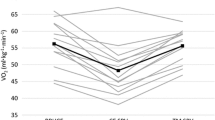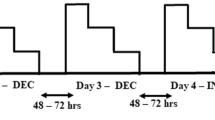Abstract
This study compared respiratory compensation thresholds (RCT) (V̇CO2 inflection point) of competitors in highly aerobic events (aerobic competitors, ARC) (n=16), competitors in highly anaerobic events (anaerobic competitors, ANC) (n=15), and untrained subjects (UT) (n=25). Maximal oxygen consumption (V̇O2max), respiratory compensation threshold as a percentage of V̇O2max (RCT), and V̇O2 at RCT (V̇O2RCT) were determined during a maximal Bruce treadmill protocol. V̇O2max (ml kg−1 min−1) was significantly greater (P<0.05) for ARC [67.2 (8.5)] than for ANC [50.0 (7.8)] and UT [43.8 (5.4)]. However, the difference between ANC and UT only approached significance (P=0.07). RCT was not significantly different between ARC [76.3 (8.7)] and ANC [80.7 (6.8)] but was significantly lower (P<0.05) for UT [62.5 (8.8)]. V̇O2RCT (ml kg−1 min−1) was significantly greater (P<0.05) for ARC [51.6 (11.0)] and ANC [40.2 (6.6)] than for UT [27.4 (5.4)], with a significant difference also between ARC and ANC. While used as a criterion for group assignment, greater V̇O2max, as well as RCT values in ARC (vs UT), reflect chronic aerobic training adaptations. ANC demonstrated V̇O2max values intermediate to ARC and UT, with RCT very comparable to those found in ARC. The results suggest subjects competitive in highly anaerobic events do not possess excessively high V̇O2max values. These individuals, however, demonstrate a high RCT when values are expressed relative to V̇O2max. Oxygen consumption at the RCT in this group is superior to that in UT but inferior to that in ARC, which likely has important implications regarding performance.




Similar content being viewed by others

References
Allen WK, Seals DR, Hurley BF, Ehsani AA, Hagberg JM (1985) Lactate threshold and distance running performance in young and old endurance athletes. J Appl Physiol 58:1281–1284
American College of Sports Medicine (2000) Guidelines for exercise testing and prescription, 6th edn. Lippincott, Williams and Wilkins, Philadelphia, Pa. pp 78–79
Beaver WL, Wasserman K, Whipp BJ (1986) A new method for detecting anaerobic threshold by gas exchange. J Appl Physiol 60:2020–2027
Borg G (1970) Perceived exertion as an indicator of somatic stress. Scand J Rehabil Med 2:92–98
Bruce RA (1971) Exercise testing of patients with coronary artery disease. Ann Clin Res 3:323–332
Coyle EF, Feltner ME, Kautz SA, Hamilton MT, Montain SJ, Baylor AM, Abraham LD, Petrek GW (1991) Physiological and biomechanical factors associated with elite endurance cycling performance. Med Sci Sports Exerc 23:93–107
Davis JA, Frank MH, Whipp BJ, Wasserman K (1979) Anaerobic threshold alterations caused by endurance training in middle aged men. J Appl Physiol 46:1039–1046
Denis C, Fouquet R, Poty P, Geyssant A, Lacour JR (1982) Effects of 40 weeks of endurance training on the anaerobic threshold. Int J Sports Med 3:208–214
Duggan A, Tebbutt SD (1990) Blood lactate at 12 km/h and vOBLA as predictors of run performance in non-endurance athletes. Int J Sports Med 11:111–115
Gaesser GA, Poole DC Gardner BP (1984) Dissociation between V̇O2max and ventilatory threshold responses to endurance training. Eur J Appl Physiol 53:242–247
Holloszy J (1982) Muscle metabolism during exercise. Arch Phys MedRehabil 63:231–234
Holloszy J, Coyle EF (1984) Adaptations of skeletal muscle to endurance exercise and their metabolic consequences. J Appl Physiol Respir Environ Exerc Physiol 56:831–838
Hurley BF, Hagberg JM, Allen WK, Seals DR, Young JC, Cuddihee RW, Holloszy JO (1984) Effect of training on blood lactate levels during submaximal exercise. J Appl Physiol Respir Environ Exerc Physiol 56:1260–1264
Itoh H, Ohkuwa T (1991) Ammonia and lactate in the blood after short-term sprint exercise. Eur J Appl Physiol 62:22–25
Ivy JL, Withers RT, Van Handel PJ, Elger DH, Costill DL (1980) Muscle respiratory capacity and fiber type as determinants of the lactate threshold. J Appl Physiol Respir Environ Exerc Physiol 48:523–527
Linossier MT, Dormois D, Perier C, Frey J, Geyssant A, Denis C (1997) Enzyme adaptations of human skeletal muscle during bicycle short-sprint training and detraining. Acta Physiol Scand 161:439–445
MacDougall JD, Hicks AL, MacDonald JR, McKelvie RS, Green HJ, Smith KM (1998) Muscle performance and enzymatic adaptations to sprint interval training. J Appl Physiol 84:2138–2142
Mafulli N, Testa V, Lancia A, Capasso G, Lombardi S (1991) Indices of sustained aerobic power in young middle distance runners. Med Sci Sports Exerc 23:1090–1096
Marcinik EJ, Potts J, Schlabach G, Will S, Dawson P, Hurley BF (1991) Effects of strength training on lactate threshold and endurance performance. Med Sci Sports Exerc 23:739–743
Marsh GD, Paterson DH, Thompson RT, Driedger AA (1991) Coincident thresholds in intracellular phosphorylation potential and pH during progressive exercise. J Appl Physiol 71:1076–1081
Pollock ML, Schmidt DH, Jackson AS (1980) Measurement of cardiorespiratory fitness and body composition in the clinical setting. Compr Ther 6:12–27
Poole DC, Gaesser GA (1985) Response of ventilatory and lactate thresholds to continuous and interval training. J Appl Physiol 58:1115–1121
Powers SK, Howley ET (2001) Exercise physiology, theory and application to fitness and performance, 4th edn. McGraw-Hill, Boston Mass., p 53
Roberts AD, Billeter R, Howald H (1982) Anaerobic muscle enzyme changes after interval training. Int J Sports Med 3:18–21
Sjodin B, Jacobs I, Svendenhag J (1982) Changes in the onset of blood lactate accumulation (OBLA) and muscle enzymes after training at OBLA. Eur J Appl Physiol 49:45–57
Stainsby W (1986) Biochemical and physiological bases for lactate production. Med Sci Sports Exerc 18:341–343
Tanaka K, Matsuura Y (1984) Marathon performance, anaerobic threshold and onset of blood lactate accumulation. J Appl Physiol Respir Environ Exerc Physiol 57:640–643
Tanaka K, Matsuura Y, Sumagai S, Matsuzaka A, Hirakoba K, Asano K (1983) Relationships of anaerobic threshold and onset of blood lactate accumulation with endurance performance. Eur J Appl Physiol 52:51–56
Tanaka K, Watanabe H, Konishi Y, Mitsuzono R, Sumida S, Tanaka S, Fukuda T, Makadomo F (1986) Longitudinal associations between anaerobic threshold and distance running performance. Eur J Appl Physiol 55:248–252
Weltman A (1995) The blood lactate response to exercise. Human Kinetics, Champaign, lll.
Weltman A, Katch V, Sady S, Freedson P (1978) Onset of metabolic acidosis (anaerobic threshold) as a criterion measure of submaximum fitness. Res Q 49:218–227
Weltman A, Seip RL, Snead D, Weltman JY, Haskvitz, EM, Evans WS, Veldhuis JD, Rogol AD (1992) Exercise training at and above the lactate threshold in previously untrained women. Int J Sports Med 13:257–263
Wilmore JH, Costill DL (1999) Physiology of sport and exercise, 2nd edn. Human Kinetics, Champaign, Ill., p 137
Wilson DF, Erecinska M, Drown C, Silver IA (1977) Effect of oxygen tension on cellular energetics. Am J Physiol 233:C135–C140
Yoshida T, Chida M, Ichioka M, Suda Y (1987) Blood lactate parameters related to aerobic capacity and endurance performance. Eur J Appl Physiol 56:7–11
Author information
Authors and Affiliations
Corresponding author
Rights and permissions
About this article
Cite this article
Green, J.M., Crews, T.R., Bosak, A.M. et al. A comparison of respiratory compensation thresholds of anaerobic competitors, aerobic competitors and untrained subjects. Eur J Appl Physiol 90, 608–613 (2003). https://doi.org/10.1007/s00421-003-0892-5
Accepted:
Published:
Issue Date:
DOI: https://doi.org/10.1007/s00421-003-0892-5



